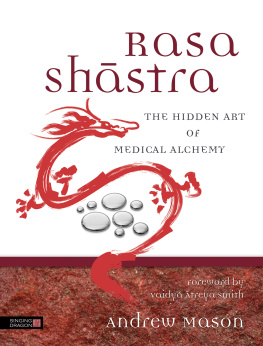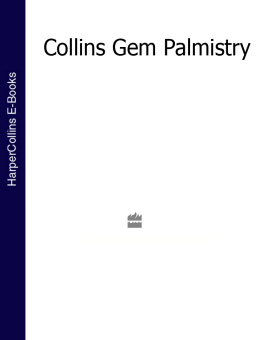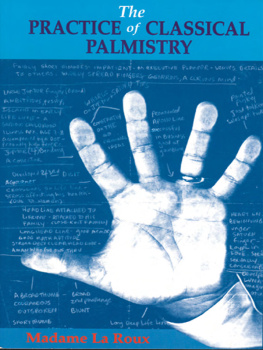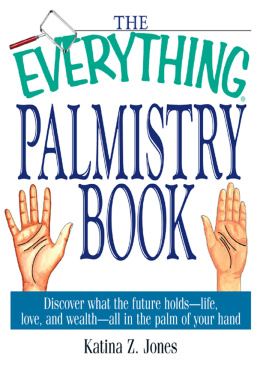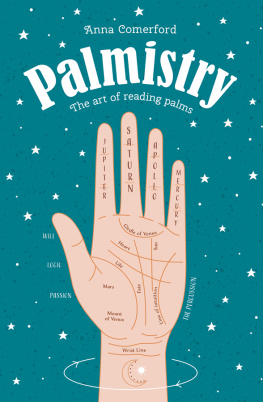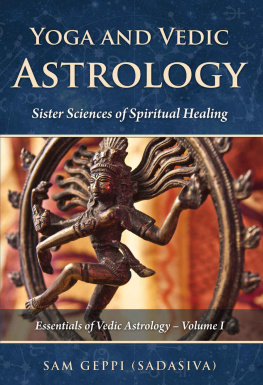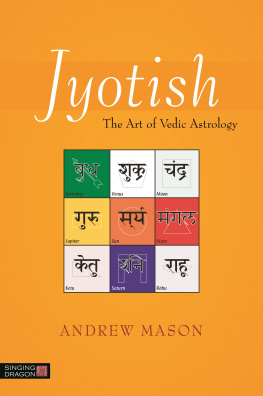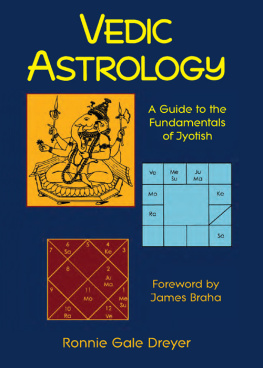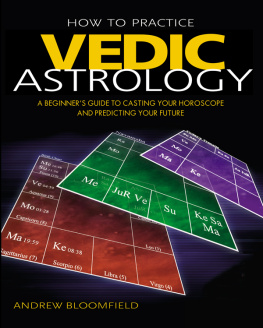
Vedic Palmistry
Hast Rekha Shstra

ANDREW MASON

LONDON AND PHILADELPHIA
CONTENTS
Introduction
VEDIC PALMISTRY
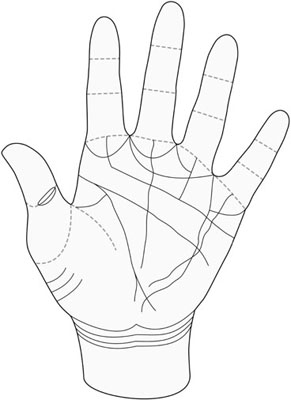


Traditional Indian Astro-palmist examining a clients palm.
A line originating from the root of the youngest finger indicates a life of a hundred years. If a line passes from the tip of the thumb to that of the forefinger it indicates shortness of life. If a line originates from the foot of the thumb and is long it indicates the possession of sons and if short indicates the possession of women.
Garuda Puna
Mention anything astrological in r Lak or India and fully expect to have your listener wave his or her palm under your nose, inquiring as to their prospects for wealth, health, longevity, spouse and progeny. Here astrology and palmistry are quite simply inseparable as any Jyotishi (astrologer) worth his salt is expected to have a good working knowledge of both. To the ancients, the hand, or more specifically its lines, detailed the will of the nine planets in their roles of karmic emissaries.
Unlike astrology, palmistry requires little understanding of planetary motion, transits or the construction of horoscopes. As we carry our hands about our person, our destiny is readily accessible, should we happen to cross the path of one adept in palmistry. This is not to say the aforementioned knowledge should be absent, as many times those skilled in palm analysis corroborate any statements with a cursory glance at their clients horoscope, or vice versa. Considered in unison, each complements one another very nicely.
Akin to precepts of Vedic Astrology (Jyotish) and traditional Indian Medicine (yurveda), among others, palmistry can appear quite simplistic to an onlooker, its core principles easily grasped within a few hours of study. However, successful application of these sciences can be the work of multiple lifetimes.
SIGNS UPON THE BODY
It does not seem possible to credit any one nation or people with the development of palmistry. However, it is thought to have been heavily influenced by early Vedic culture, Nowhere were these signs taken with more seriousness than those written upon the palm, hands (after all) being the appendage most likely to feature in the success or downfall of an individual.
Hast Sanjivan , or portraits of the living hand, are often grouped into a number of categories such as those present from birth, those developed with age and, finally, inherited lines from injury, mutilation or bad posture. One of the earliest and most important categories of sign interpretation was that arising from the decipherment of birthmarks or lines taking the form of auspicious/inauspicious objects. One example of auspiciousness might be Padma (a lotus flower), identified with purity, compassion and clarity of mind. Conversely, Sarpa (snakes) were commonly identified with strife, hidden dangers or an uncertain future and so considered unlucky.
REKHAS (LINES)
Unlike the fixedness of a horoscope, lines upon the palm appeared subject to development, at times appearing, merging or fading. Lines were thought to coalesce or disburse as one accrued or discharged karmic debts. A detailed cataloguing of your own palm, over a period of years, often reveals an almost imperceptible shifting of secondary and miscellaneous lines. Primary lines such as life (yu), head (Matru), heart (Hrdaya) and fate (karma) appear less subject to change, as these constitute the foundation stones of life, and as such are unlikely to be modified to any great extent. That being said, smaller tributaries or branches, feeding into or away from these primary lines, may be greatly influenced with the passing of years.
A childs palm often appears simplistic or shallow in contrast to those of young adults or the furrowed, darkened adult examples. Some individuals bear few lines but those visible have both depth and gravity, appearing to drain or dwarf subsidiary lines. Other palms may show bewildering dendritic patterns, with no one line appearing to stand apart from its comrades. Overly simplistic examples like these may reflect how an individual feels their life to unfold, that is, the former feeling swept downstream with little chance to react, seemingly driven to a focal point, while the latter experiences constant side-tracking and detours, which eventually seem to return them to a similar set of circumstances.
OVERVIEW OF THE BOOK
Palmistry forms an important branch of Indias predictive sciences, its volume and wealth of knowledge remaining vast. Throughout the pages of this book I have tried to distil its quintessential factors into something both practical and informative for the reader. Vedic Palmistry is here presented in five bite-size partitions that are best considered pieces of a delicate puzzle that stand alone or if taken in totality lock neatly together, helping to cognise the subjects importance. As the number 5 is symbolic of the totality of fingers + thumb (on a hand), and 5 is the numeral most associated with occult sciences, its use here seems most appropriate.
Part I discusses the topography of the hand, along with a brief intro-duction to yurvedic concepts of health, vitality and constitutional typing. This section also considers the three primary states of matter, known as Gunas , identifying their varying locations on palm and fingers.
Part II shows how the lines (Rekhas) can take the form of complex symbols, be conjoined or stand alone. Here we examine their numerous manifestations and interpretations, along with fingerprints ( Hast-mudr ) and timelines (Klamna Rekha), the latter offering a means to judge their manifestation.
Part III looks at the planets (Grahas) and zodiac signs (Rashis) as revealed upon the palm and fingers. Correlations between planets, zodiac signs and the individual are paramount to any understanding of palmistry. This section introduces each planet through a series of portraits, their significations, temperaments, mounds (on the palm) and associated lines.
Part IV covers the Nakshatras on the palm and fingers. Often referred to as lunar mansions, Nakshatras support any analysis of lines. Understand-ing their significations and propitiatory acts is considered key to placating or empowering the lines inscribed upon our palms.
Part V investigates prescribed methods of planetary appeasement. This very traditional component of Hast Rekha (and Jyotish) aims to counteract (negative) or enhance (positive) planetary forces through the use of mantra, yantra, gemstones, among others.
NOTES
Palmistry, in the ancient world, may have been the preferred method of analysis by astrologers, having instant access to all planetary influences conveniently placed in the palm of the hand.
There remains conjecture over the true origins of this tradition, with Samudra Rishi believed to have compiled one of the earliest treaties on Smudrikam including Hast Rekha Shstra.
Shat Smudrika Shstra : date, author and true origination remain unclear. Other references (in antiquity) to the practice of palmistry occur in Puric texts such as Vyu Pura (Chapter LVII), Garuda Pura (Chapter LXV) and Agn Pura (Chapter CCXLII), as well as Brihat Sahit (Chapter LXVIII), authored by the esteemed astrologer and astronomer Varhamihira. Additionally, tenuous references to hand and fate are found in Rig Veda (Hymn CVXII) and Atharva Veda Sahit VII 52.8.
Next page

